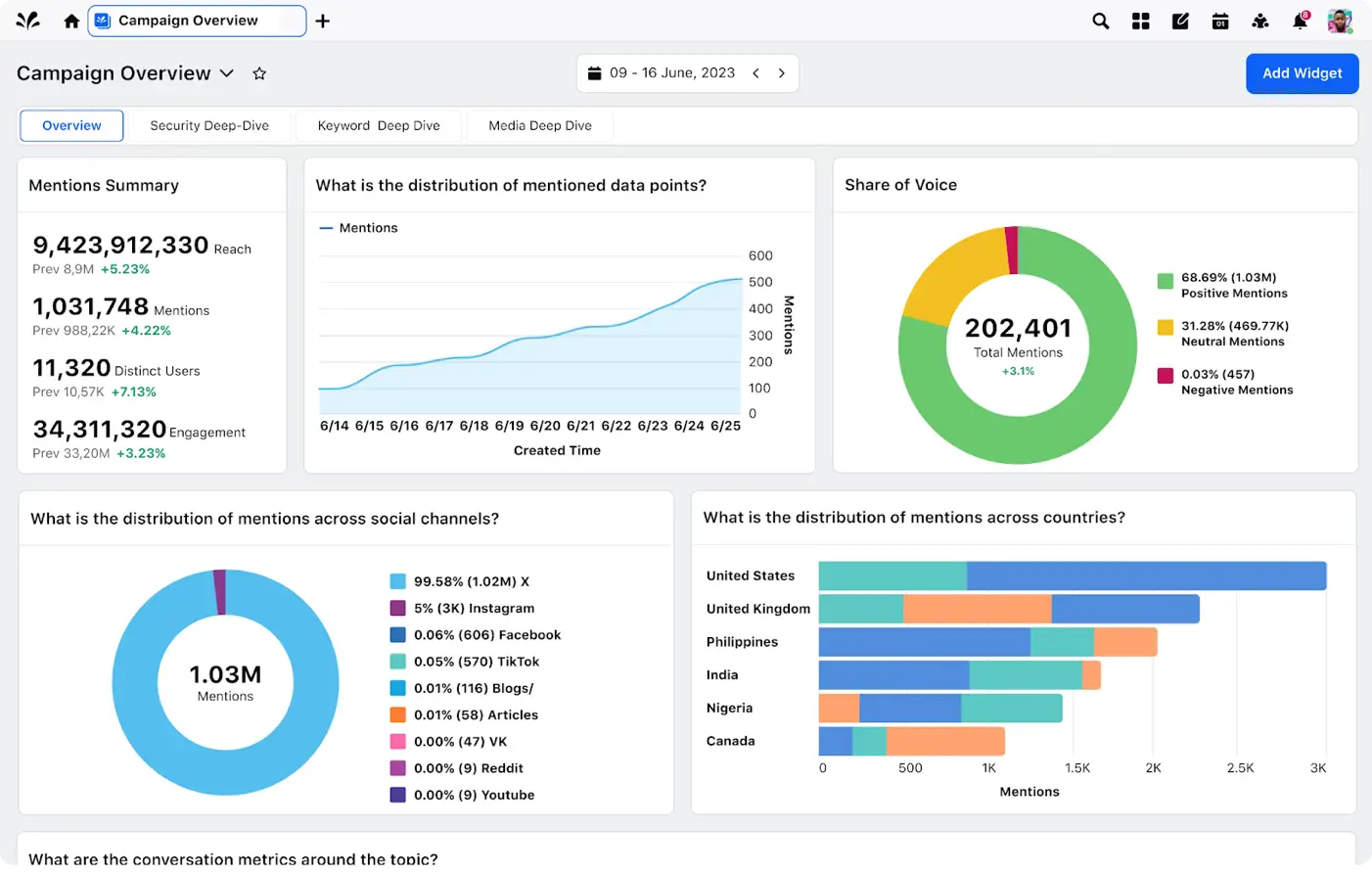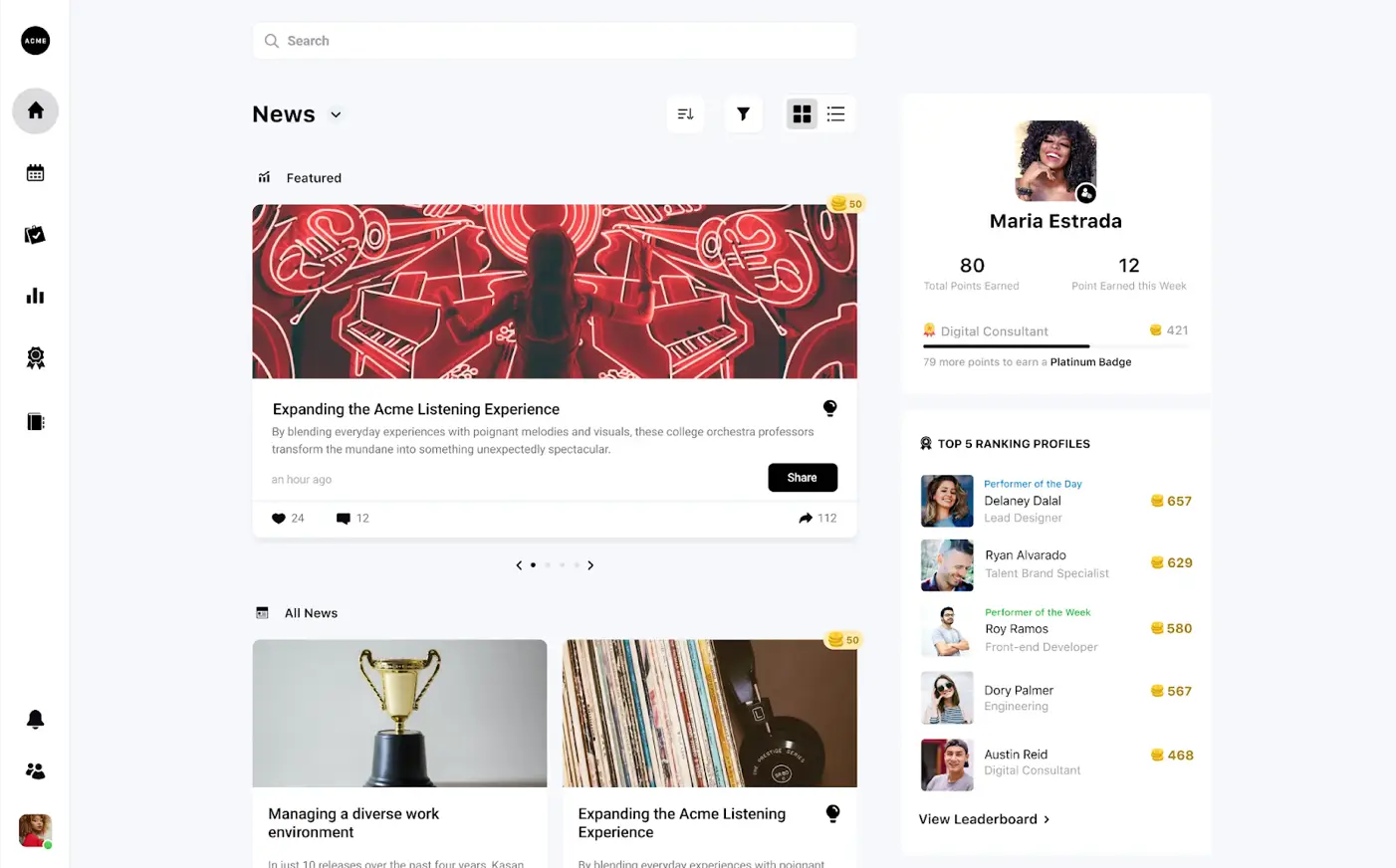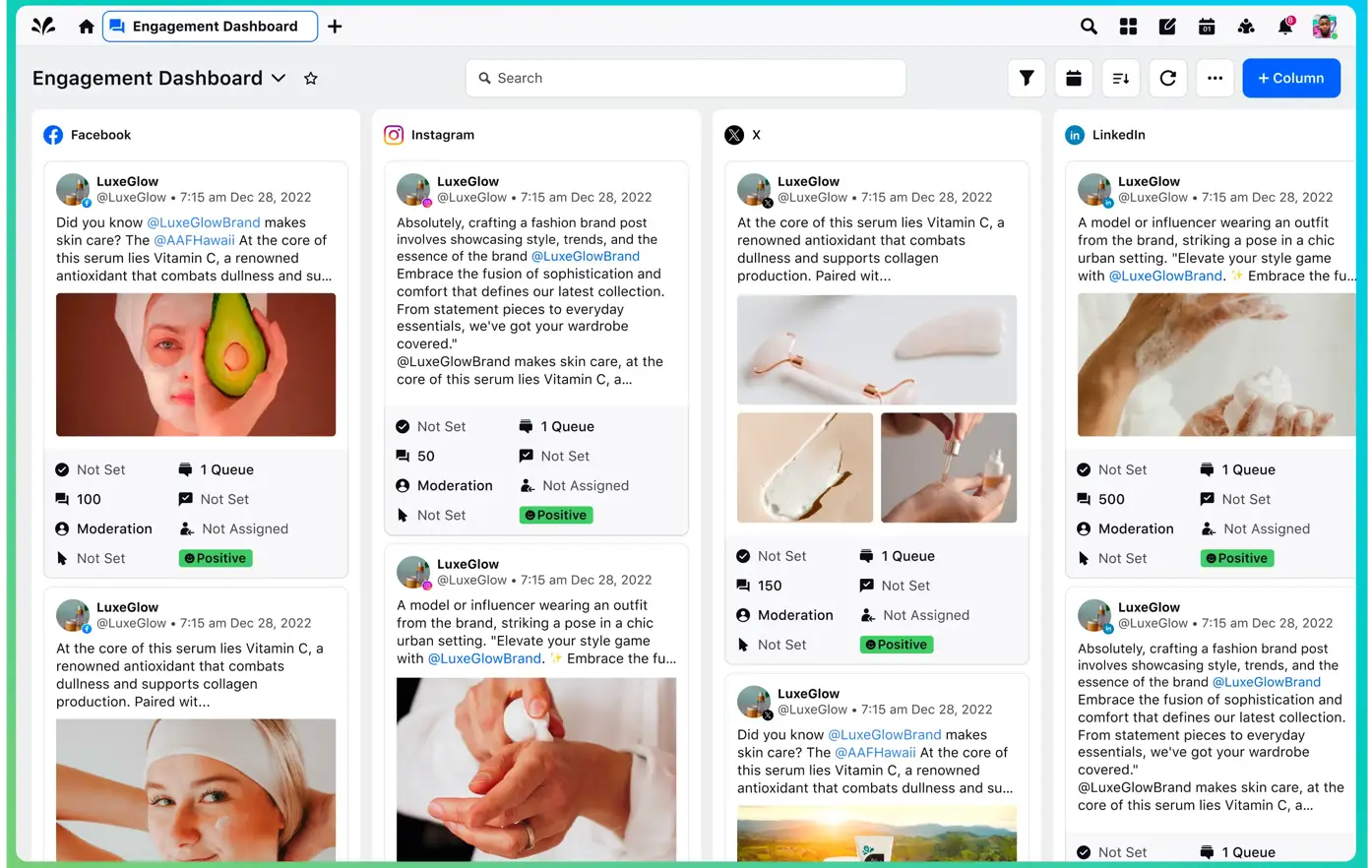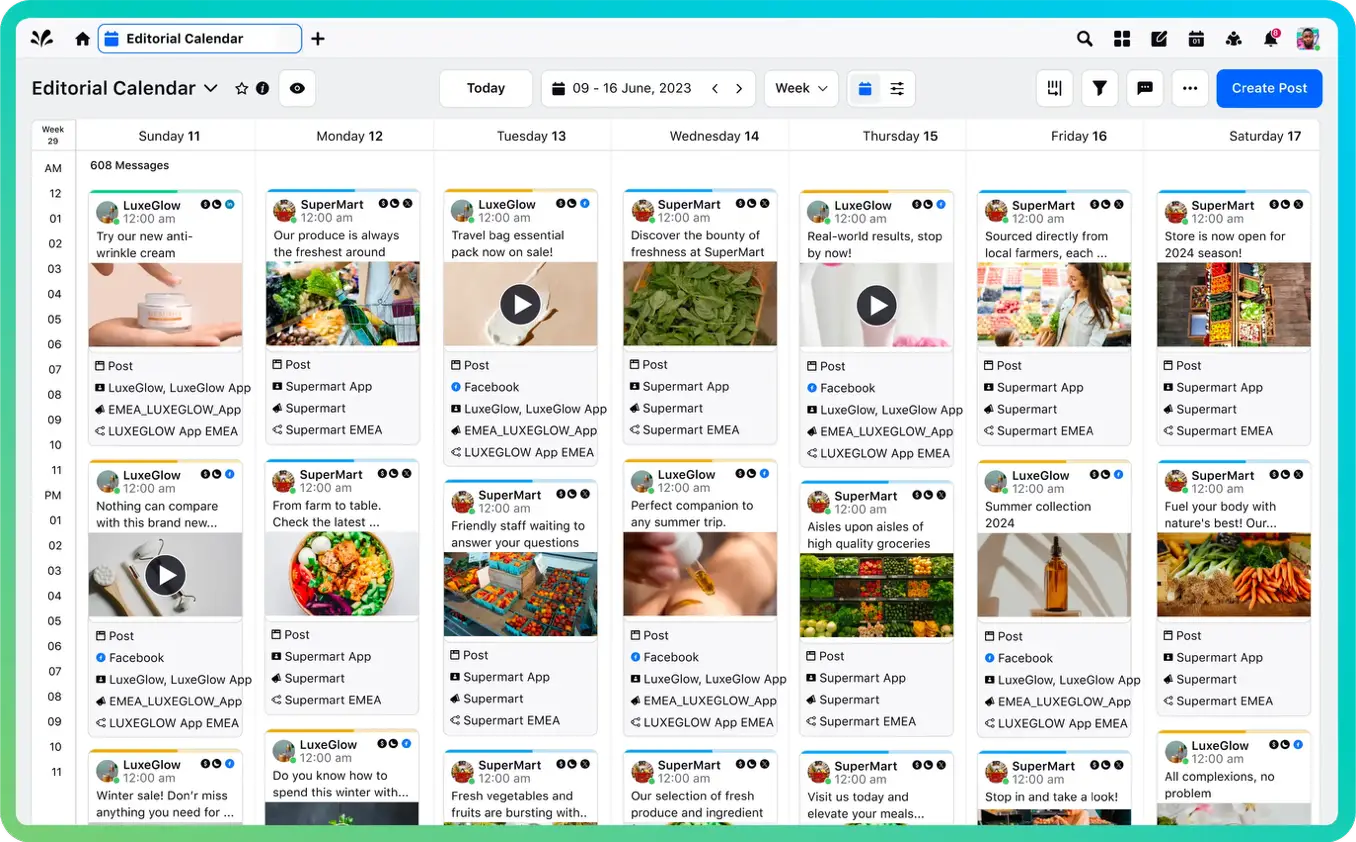The global leader in enterprise social media management
For over a decade, Sprinklr Social has helped the world’s biggest brands reimagine social media as a growth driver with a unified platform, industry-leading AI and enterprise-grade scale.

B2B Social Media Marketing: 5 Strategies & 7 Tips
B2B social media marketing uses platforms like LinkedIn, X, Facebook, and Instagram to foster relationships with potential and existing clients by sharing industry-relevant content and engaging decision-makers through longer sales cycles.
According to Gartner, 40% of B2B buyers rely on social media to inform their purchase decisions. That's why marketing leaders now allocate 12.2% of their budgets to social media.
But here's the gap: most B2B social strategies are disconnected from intent signals, sales enablement workflows, and revenue attribution models. And this limits their impact on pipeline velocity and deal closure.
How do you approach B2B social media marketing that makes an impact and drives your bottom line?
We discuss five strategies to drive higher-quality leads, deepen engagement from target accounts, and measure outcomes across your funnel through social media.
Why social media marketing is essential for B2B companies
Here is a breakdown of the business, strategic, and competitive reasons for B2B orgs using social media marketing:
Business reasons
1. You can transform social data into customer intelligence
Every comment, share, and mention contains valuable insights about what your customers need and how they discuss their challenges.
Social media is "the world's largest open-source focus group," and you can use it to spot emerging trends, test positioning, and refine messaging before market shifts occur.
For example, Microsoft uses Sprinklr Insights, a consumer intelligence platform, to glean 8.1 billion conversations from social and digital channels around remote work. It then uses the information to shape its thought leadership content.
Here's a preview of a Sprinklr Insights reporting dashboard, which provides a breakdown of top keywords and language analytics for a social media campaign.
With billions of unstructured conversations scanned and analyzed, you can see an overview of the impact your social media, PR, brand outreach, or any public-facing efforts are making.
The intelligence, whether from consumers or competitors, helps you make data-driven decisions and stay ahead of customer needs.
⚡See Sprinklr Insights in action — how you can track social media efforts across 30+ channels from 1 unified platform

2. You can build brand authority and thought leadership
Social media platforms like LinkedIn, X, and Reddit are channels to establish B2B industry expertise.
"Perhaps one of the more understated benefits of social media in B2B is the ability to establish and foster expertise within a given industry or niche," says marketing strategist Brian Solis.
Your prospects and customers are likely to flock to professional or specialized social media platforms. Your presence as a thought leader or regular member helps reinforce your brand values and offerings to them.
Thought leadership content, for example, builds trust, which is essential for high-value B2B purchases.
ACCIONA, a leader in infrastructure and renewable energy, demonstrates this by producing sponsored content on LinkedIn that reached over a million unique individuals with completion rates well above benchmarks.
3. You can generate high-quality leads
Sixty-eight percent of B2B marketers, according to a survey, suggest that social media generates more leads.
Platforms like LinkedIn enable direct connection with decision-makers and potential clients through built-in tools like Sales Navigator.
The platform-audience fit on social media is also essential. It helps deliver targeted content that resonates with specific buyer personas and generates high-quality leads.
For example, you can drive LinkedIn users to your product landing page, webinar, or gated content (e.g., whitepapers, reports) and collect emails and qualify leads.
An omnichannel presence is important here since B2B sales cycles are longer and require multiple touchpoints with qualified prospects. Social media makes this possible with the correct strategy and platform.
If you use a social media management platform, you can integrate it with your CRM or other internal tools to manage leads and their journey after they qualify on social👇.
For more complex setups, you can sync data both ways (e.g., a qualified lead in Sprinklr triggers a workflow in your sales system or updates a ticket in ServiceNow) using Sprinklr’s open API.
Strategic reasons
4. You can improve customer experience and support
Your clients increasingly expect responsive customer service through social channels. This requirement makes social media a de facto channel for customer service.
You can transform your social media channels into effective customer support hubs, providing faster resolution times and building stronger relationships.
For example, Wells Fargo turns their social media channels into a unified front office. This enables their agents to help customers quickly and efficiently, regardless of which channel they use to contact the bank.
Agents work in Sprinklr Service’s Agent Console, where AI-powered Agent Assist automates a high volume of decisions and actions, helping Wells Fargo increase revenue opportunities, reduce costs, and manage risk.
5. You can build and nurture professional communities
The correct social media platform for your business serves as a meeting place where you can engage with your audience and foster long-term relationships.
Consider a cloud security software company in NYC that uses YouTube. They don't just post product demos, they:
- Create in-depth tutorials on cybersecurity best practices
- Host weekly webinars addressing current security threats
- Produce case study videos showing real-world problem-solving
- Comment on and collaborate with other cybersecurity channels
- Create educational series about compliance requirements (like GDPR, SOX)
- Respond to comments with detailed technical advice
- Build playlists for different audience segments (CISOs, IT managers, developers)
This consistent, educational content approach transforms viewers into a community of IT professionals who trust the company's expertise and think of them first when security needs arise.
Here’s Wiz Security’s YouTube handle showing educational and value-added content on cloud security and data👇
As David Meerman Scott notes, "the fundamentals of B2B marketing are the same today as they were 50 years ago. It's still about relationships, although today we have new tools and techniques at our disposal."
Social media acts as a powerful relationship-building channel for B2B brands.
6. You can do social selling across the funnel
Social selling is a modern sales strategy where you use social media platforms (like LinkedIn, X/Twitter, Facebook, and Instagram) to build trust-based relationships with prospects and customers. The goal is delivering value and authenticity rather than aggressive outreach.
When done correctly, social selling drives full-funnel conversions, not just brand awareness.
Here’s an example of a popular B2B SaaS brand, Ahrefs, using LinkedIn to share how their product can solve a common problem of creating on-brand content.
Companies winning in 2025 use social media to nurture intent, personalize outreach, and shorten sales cycles.
This strategic approach transforms social platforms from mere marketing channels into revenue-generating engines that support the entire customer journey.
Competitive reasons
7. You can gain a first-mover advantage in digital transformation
While 87% of B2B companies use social media platforms to enhance their content marketing strategies, many still operate at intermediate maturity levels.
If you invest early in sophisticated social media strategies and platforms, you gain competitive advantages through better audience insights, improved brand positioning, and stronger customer relationships.
One example of driving an incredible amount of engagement using social media is through employee advocacy, which we discussed before in this post.
See how L’Oréal uses social media to drive 12M organic impressions and $200K+ media value using the Sprinklr Social platform.
🔥Increase social media reach by up to 360% in 6 months via employee advocacy
Amplify your brand voice, improve awareness, generate leads, and attract talent through Sprinklr’s employee advocacy platform.

8. You can access decision-makers where they spend time
Eighty-five percent of B2B buyers believe companies should present information via social networks, yet only 20% of CMOs use social networks to engage with customers.
This gap represents a significant competitive opportunity for you to use social media proactively.
Consider how Salesforce uses LinkedIn. Apart from the regular product updates, it shares customer success videos, hosts live events, and spotlights thought leaders across industries.
This consistent engagement has turned their social presence into an extension of their sales funnel, keeping them top-of-mind for decision-makers long before a formal pitch.
If you think it’s a steady drumbeat of value-driven content that has helped Salesforce nurture leads long before a sales conversation even begins.
9. Do cost-effective marketing with higher ROI
Social media marketing is exceptionally more cost-effective compared to traditional B2B marketing channels.
An independent Forrester Consulting Total Economic Impact™ study, commissioned by Sprinklr and published on July 1, 2024, found that the composite “Sprinklr Social” customer got a 327% ROI over three years.
Sprinklr Social is a platform that Fortune 100s use to manage their social media as a strategic channel.
How does it, or other similar platforms, help do effective social media marketing?
Thanks to the ability to reach global audiences without massive budgets, you get competitive pricing advantages and higher profit margins when you market or sell through social media.
For example, brands that use Sprinklr Social for their social media have the potential to save:
- $5.2M in social content creation time through unified asset workflows
- $1.38M on paid media by leveraging employee advocacy
- $1.28M time savings in reporting and analytics
- $728K reduced churn, thanks to AI-driven monitoring and engagement
- $516K incremental profit from social commerce improvements (10% drop in abandoned carts, 15% rise in average order value)
🔥 Manage your social media across multiple teams, brands, and geographies, from 1 unified platform

10.Stay competitive through continuous innovation
The B2B social media landscape evolves rapidly, with new content formats, features, and audience behaviors emerging regularly.
If you can adapt quickly to trends like video content, interactive storytelling, and personalized messaging, then you maintain a competitive edge over slower-moving competitors.
As marketing expert Jay Baer states, "Content is fire, social media is gasoline.” Social amplification can accelerate your competitive advantages.
Suppose you have a strong social media content strategy with enough flexibility to pivot when market forces shift. In that case, you can iterate on what content works and what lags, ultimately perfecting your presence before competitors.
Also read: How social selling helps build your B2B sales pipeline
4 proven strategies to drive results with B2B social media marketing
These five strategies are designed for enterprise marketing leaders seeking to move beyond surface-level engagement metrics:
1. Focus on narratives that convert rather than high-volume publishing
B2B decision-makers respond to content that clarifies complexity or reframes strategic priorities.
They’re, in most cases, answerable to stakeholders, boards, investors, and so on.
So, they want to know how your communication/product/service will solve their problem.
Publishing frequently without substance often results in content fatigue and low-value engagement.
On the other hand, thought-provoking insights grounded in data, customer trends, or strategic frameworks position your brand as a leader worth following.
For example, refer to how McKinsey does not rely on volume. Instead, they share structured perspectives on themes like geopolitical risk, digital transformation, and workforce innovation 👇
These posts consistently attract attention from C-suite audiences because they offer depth, not just visibility.
The point is to leverage the platform and its audience to deliver content in the most effective format and narrative for each social media platform.
💡Pro tip: Use Sprinklr Marketing platform to understand how your audience responds to your content and creatives based on theme, tone, sentiment, and visual attributes.
The Content Marketing suite shows the following in one platform:
- AI-generated topic suggestions
- Editorial calendar view with scheduled posts aligned to industry events
- Performance analytics dashboards tracking engagement metrics and content impact

Know more: How to set social media goals for your business
2. Build credibility by amplifying the voices of stakeholders and customers
B2B buyers are more likely to act on insights from peers and subject matter experts than on your branded messaging or corporate claims.
You must use social media to amplify your team’s voices that can appeal to your prospects.
Showcasing perspectives from customers or internal experts builds trust and backs your solution with real-world proof.
You can develop an employee advocacy program with your team, maintaining a content calendar or schedule where team members regularly post on topics they excel in.
If you want to roll out the advocacy program at a larger, org-wide level, invest in an employee advocacy platform to make it easy to amplify their voices with regulated, compliant content.
Here’s an example of Sprinklr’s employee advocacy dashboard where your team members get a profile documenting their activities and all the approved content to share in a jiffy 👇
Example: Gong frequently features customer outcomes, sales leadership insight, and user testimonials across their LinkedIn posts.
It helps prospective buyers see how similar companies benefit from Gong’s solutions, making the value proposition more relatable and actionable.
3. Adapt content formats to align with different platforms
Different platforms attract different buyer behaviors. You must use behavioral signals to tailor messaging, choose optimal posting times, and target content by funnel stage.
A post that performs well on LinkedIn might underperform on X or Instagram due to differences in user intent, content length tolerance, and visual expectations.
To ensure maximum impact, adapt the content to fit the format, tone, and structure native to each platform.
If you want to scale it up, look for platforms like Adobe’s B2B Journey Optimizer.
It uses AI to identify “buying groups” and roles within (e.g., VP of IT, Director of Demand Marketing), which you can use to craft persona-based, highly personalized content across channels such as email, web, chat, and webinars.
A whitepaper might become a carousel on LinkedIn, a stat-rich thread on X, and a short vertical video for YouTube Shorts. These adaptations increase the shelf life and impact of core content.
4. Turn “hidden” social insights into targeted, intent-driven campaigns
B2B buyers often share and discuss content in semi-private channels like public Reddit threads, open Discord channels, public Telegram groups, forums, and review sites.
These engagements aren’t easily visible or traceable in your regular analytics.
But these “hidden” interactions can indicate early-stage interest long before a formal inquiry is made.
A social listening platform like Sprinklr Insights can help correlate these social activities, such as branded or related mentions, content shares, share of voice, asset downloads, and downstream engagement.
AI insights built into the platform can help you detect individual sharing behavior of your target audience across regions or accounts, uncovering which content themes trigger early buyer interest.
This intelligence supports more targeted outreach and helps prioritize high-interest accounts before competitors engage.
Also read: How AI is transforming social media
How to create a B2B social media strategy
Social media marketing differs significantly between B2B and B2C. Here's how:
1. Define business objectives and align KPIs
Set clear, outcome-oriented goals for your social efforts. These might include increasing qualified leads, expanding share of voice, improving demo-to-close rates, or driving high-intent traffic to your website.
How to implement it: Establish KPIs such as engagement-to-MQL ratio, demo conversions, CPL (cost per lead), or share of voice in priority markets.
2. Map audience personas and buying committee roles
Identify key decision-makers and influencers in your ICP (ideal customer profile).
Understand their responsibilities, pain points, content preferences, and where they seek peer validation.
How to implement it: Use CRM data, sales team input, and AI-powered audience analysis to build rich, behavior-based personas. Track how each stakeholder type engages across the journey.
3. Audit your presence and select the right platforms
Evaluate your current brand presence across social platforms and identify where your buyers are most active.
Audit past performance, engagement trends, and platform ROI.
How to implement it:
- Assess sentiment, share of voice, and competitive positioning of your content and social media activity
- Then, prioritize:
o LinkedIn for ABM and executive influence
o YouTube for deep product education
o X (Twitter) for real-time insights and event amplification
o Reddit, Discord, Slack for niche, peer-to-peer validation
4. Build a buyer-journey-aligned content strategy and plan your calendar
Develop content pillars that map to different buying stages — from awareness and consideration to decision and advocacy. Plan this content across quarters.
How to implement it: Use a shared editorial calendar to schedule webinars, thought leadership, analyst reports, case studies, product tutorials, and event-based content.
To automate the editorial calendar, you can check out Sprinklr’s social media publishing platform.
5. Activate employee advocacy and executive branding
Enable your executives and employees to post authentic, relevant content around campaigns, trends, and industry topics.
How to implement it: Create ready-to-share templates and suggested copy. Recognize top internal advocates.
Also read: What is employee advocacy and its best practices
6. Optimize continuously with real-time performance intelligence
Track performance weekly using metrics aligned to your KPIs. Monitor engagement trends, post-level data, and sentiment insights. You can use these social media mmonitoring tools for daily tracking.
How to implement it: Use AI to test formats, timings, and messages. Refine targeting based on ICP behavior and performance feedback loops.
7. Create a reporting workflow and share insights across teams
Establish monthly or quarterly social media reporting to show how social efforts contribute to business outcomes. Share insights with leadership, sales, and product teams.
How to implement it: Create dashboards that showcase key trends, top campaigns, content ROI, and MQL contribution. Use insights to refine messaging and campaign strategy.
Check this: Infographic: How to reach your target audience on social media
How B2B social media marketing differs from B2C
Social media marketing is not entirely the same for B2B and B2C. Here’s how:
Dimension | B2B social media | B2C social media |
Audience intent | Research-driven, focused on ROI, credibility, and solving business problems | Emotion-driven, focused on personal benefit, entertainment, or lifestyle fit |
Buyer journey | Long, multi-stage, includes several stakeholders (IT, finance, leadership) | Shorter, more direct, often a single decision-maker |
Content format | Thought leadership, case studies, whitepapers, webinars, industry insights | Product promotions, influencer content, brand storytelling, short-form videos |
KPIs | SQLs, demo bookings, pipeline velocity, customer retention | Clicks, likes, follows, conversions, purchase volume |
In short, B2B marketers must prioritize value over virality, depth over reach, and relationship-building over rapid sales, especially when social is expected to influence revenue outcomes, not just engagement metrics.
Use B2B social to accelerate deal cycles and influence high-intent accounts
A well-structured B2B social strategy connects every post, reply, and campaign to clear business KPIs, reputation uplift, lead quality, stakeholder influence, or even customer retention.
And with the right tools like Sprinklr Social, you can manage this complexity at scale, ensuring brand consistency, regulatory compliance, and real-time optimization across 30+ channels.
Book a demo now to see how Sprinklr helps B2B social media teams publish precisely and engage decision-makers.
Frequently Asked Questions
Examples of B2B Social Media Marketing include LinkedIn leadership content, client success stories on Instagram, and educational YouTube explainers. Brands often leverage webinars, live Q&As, and industry report snippets to build credibility and nurture leads.
LinkedIn remains the best social media platform for B2B marketing in 2025 due to its robust targeting and professional ecosystem. X (Twitter), YouTube, and TikTok are also rising channels for thought leadership and awareness among niche buyer segments.
Social listening reveals valuable insights into audience sentiment, competitor positioning, and emerging B2B Social Media Marketing trends. With these inputs, marketers can fine-tune messaging and stay ahead of shifting industry conversations.
AI enhances B2B Social Media Marketing strategy by automating content creation, identifying optimal posting times, and delivering predictive analytics. It also personalizes engagement across touchpoints, improving campaign efficiency at scale.
ROI can be tracked through metrics like lead quality, influenced revenue, and customer acquisition costs, often using tools like UTMs and CRM integration. Clear attribution models help connect B2B Social Media Marketing efforts to actual business outcomes.
While not mandatory, paid advertising significantly boosts visibility and leads generation, especially when combined with organic efforts. It’s often a critical lever in a results-driven B2B Social Media Marketing strategy.
Platforms like Sprinklr offer scheduling, analytics, and collaboration features tailored for enterprise needs. These tools are essential for executing a scalable B2B Social Media Marketing operation across teams and regions.










